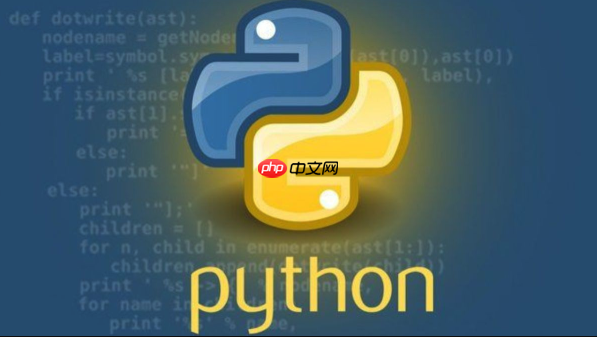python本身不会识别过度复杂的条件表达式,真正需要识别并管理这种复杂性的是开发者。当代码出现难以理解、维护困难、测试复杂等现象时,说明条件表达式可能过于复杂。解决方法包括:1. 通过直观感受判断,如反复阅读、嵌套层级超过两层;2. 使用静态分析工具(如radon、flake8-simplify、pylint)量化复杂度,圈复杂度是关键指标;3. 通过重构技巧简化逻辑,如使用卫语句、提取函数、字典映射、策略模式、拆解布尔表达式、使用all()/any()等。

Python本身并不会“识别”过度复杂的条件表达式,它只是忠实地执行你写下的每一行代码。真正需要识别并管理这种复杂性的是我们开发者。当我们发现代码中存在难以理解、维护困难、测试噩梦般的
if/elif/else
if
and
or

解决方案 要识别和处理Python中过度复杂的条件表达式,我们通常会从几个维度入手:直观感受、代码度量工具和重构策略。首先是直观感受:当你在看一段代码时,如果需要反复阅读、在脑海中模拟各种条件组合才能理解其逻辑,或者发现
if
为什么过度复杂的条件表达式是个问题? 过度复杂的条件表达式,坦白说,就是代码的“坏味道”之一。它首先直接冲击的是可读性。想象一下,一个
if
and
and
or

然后是维护成本。逻辑越复杂,修改起来就越容易出错。你可能只是想调整一个边界条件,结果却不小心影响了其他看似不相关的逻辑路径。这就像在精密仪器里随便拧一个螺丝,你不知道它会影响哪个部件。调试也成了噩梦,因为可能的执行路径太多,难以定位问题。
再者是测试难度。为了确保所有逻辑分支都按预期工作,你需要编写大量的测试用例。一个简单的
if/else
and
or
立即学习“Python免费学习笔记(深入)”;

最后,从深层来看,它增加了潜在的bug风险。人脑处理复杂逻辑的能力是有限的,越复杂的条件越容易在编写时出现逻辑漏洞,或者在后期修改时引入新的错误。这不仅拖慢了开发进度,更可能导致线上事故。所以,简化条件表达式,不只是为了代码好看,更是为了代码的健壮性和项目的可持续发展。
如何衡量条件表达式的复杂度? 衡量条件表达式的复杂度,最常用的就是圈复杂度(Cyclomatic Complexity)。这个概念其实很简单,它量化的是一个函数或方法中独立线性路径的数量。你可以把它想象成代码的“岔路口”数量:一个
if
for
and
or
在Python中,我们通常不会手动去数这些路径,而是依赖工具。
radon
radon cc your_module.py
# 安装radon pip install radon # 使用radon检查文件 radon cc your_file.py
flake8-simplify
flake8
if
else
pylint
pylint
除了工具,一些经验法则也能帮助我们判断:
if
and
or
if/else
if
简化复杂条件表达式的实用技巧有哪些? 简化复杂条件表达式,核心思想是“拆解”和“抽象”。目标是让每个判断逻辑清晰、单一,减少嵌套,提高可读性。
1. 早期返回/卫语句(Guard Clauses) 这是最直接也最有效的技巧之一。当函数在处理正常逻辑前,需要检查一些前置条件(比如参数是否合法、对象状态是否正确)时,与其用
if
# 复杂版本
def process_data(data):
if data is not None:
if isinstance(data, list):
if len(data) > 0:
# 核心处理逻辑
return [item * 2 for item in data]
else:
return []
else:
raise TypeError("Data must be a list.")
else:
raise ValueError("Data cannot be None.")
# 卫语句版本
def process_data_simplified(data):
if data is None:
raise ValueError("Data cannot be None.")
if not isinstance(data, list):
raise TypeError("Data must be a list.")
if not data: # 检查空列表
return []
# 核心处理逻辑,现在没有深层嵌套了
return [item * 2 for item in data]你看,通过把异常情况提前处理并返回,主流程的逻辑就变得扁平多了。
2. 提取方法(Extract Method) 如果一个条件表达式的逻辑非常复杂,或者它包含了一段独立的、有明确意义的业务逻辑,那就把它提取成一个新的函数。给这个新函数一个有意义的名字,这样主函数的逻辑就变得更清晰,就像阅读一个故事大纲。
# 复杂版本
def calculate_discount(customer, order_total, is_vip, has_coupon):
if customer.is_new_customer and order_total > 100:
discount = 0.1
elif is_vip and order_total > 50:
discount = 0.15
elif has_coupon and order_total > 20:
discount = 0.05
else:
discount = 0
return order_total * (1 - discount)
# 提取方法版本
def _get_base_discount(customer, order_total):
if customer.is_new_customer and order_total > 100:
return 0.1
if customer.is_vip and order_total > 50: # 假设is_vip是customer的属性
return 0.15
return 0
def calculate_discount_simplified(customer, order_total, has_coupon):
discount = _get_base_discount(customer, order_total)
if has_coupon and order_total > 20 and discount == 0: # 假设优惠券不与基础折扣叠加
discount = 0.05
return order_total * (1 - discount)这里
_get_base_discount
calculate_discount_simplified
3. 使用字典/映射(Use Dictionaries/Maps) 当你的
if/elif/else
# 复杂版本
def get_status_description(status_code):
if status_code == 200:
return "OK"
elif status_code == 400:
return "Bad Request"
elif status_code == 404:
return "Not Found"
elif status_code == 500:
return "Internal Server Error"
else:
return "Unknown Status"
# 字典映射版本
STATUS_DESCRIPTIONS = {
200: "OK",
400: "Bad Request",
404: "Not Found",
500: "Internal Server Error"
}
def get_status_description_simplified(status_code):
return STATUS_DESCRIPTIONS.get(status_code, "Unknown Status")这种方式特别适合于固定映射关系,代码量大大减少,且易于扩展。
4. 策略模式/多态(Strategy Pattern/Polymorphism) 当不同的条件对应着不同的“行为”时,可以考虑使用面向对象的多态性或策略模式。为每种行为定义一个独立的类,然后根据条件创建对应的类实例并调用其方法。这在处理复杂业务规则时非常强大。
# 假设有不同的支付方式,每种方式有不同的处理逻辑
# 复杂版本(伪代码)
def process_payment(method, amount):
if method == "credit_card":
# 大段信用卡处理逻辑
pass
elif method == "paypal":
# 大段PayPal处理逻辑
pass
elif method == "alipay":
# 大段支付宝处理逻辑
pass
else:
raise ValueError("Unknown payment method")
# 策略模式版本(概念)
class PaymentStrategy:
def process(self, amount):
raise NotImplementedError
class CreditCardPayment(PaymentStrategy):
def process(self, amount):
print(f"Processing credit card payment for {amount}")
class PaypalPayment(PaymentStrategy):
def process(self, amount):
print(f"Processing PayPal payment for {amount}")
class AlipayPayment(PaymentStrategy):
def process(self, amount):
print(f"Processing Alipay payment for {amount}")
PAYMENT_METHODS = {
"credit_card": CreditCardPayment(),
"paypal": PaypalPayment(),
"alipay": AlipayPayment()
}
def process_payment_simplified(method, amount):
strategy = PAYMENT_METHODS.get(method)
if not strategy:
raise ValueError("Unknown payment method")
strategy.process(amount)这样,每种支付方式的逻辑都被封装在自己的类中,
process_payment_simplified
5. 布尔表达式拆解(Decompose Boolean Expressions) 如果一个
if
and
or
# 复杂版本
def is_eligible_for_promotion(user, product, order_value, is_first_purchase):
if (user.is_premium or user.lifetime_value > 1000) and \
(product.category == "electronics" or product.is_bestseller) and \
(order_value > 500 and is_first_purchase):
return True
return False
# 拆解版本
def is_eligible_for_promotion_simplified(user, product, order_value, is_first_purchase):
is_loyal_customer = user.is_premium or user.lifetime_value > 1000
is_eligible_product = product.category == "electronics" or product.is_bestseller
is_high_value_first_order = order_value > 500 and is_first_purchase
return is_loyal_customer and is_eligible_product and is_high_value_first_order通过引入中间变量,即使条件复杂,也能一眼看出每个部分的含义。
6. 使用 all()
any()
all()
any()
if
# 复杂版本
def all_students_passed(scores):
for score in scores:
if score < 60:
return False
return True
# 使用 all()
def all_students_passed_simplified(scores):
return all(score >= 60 for score in scores)
# 复杂版本
def has_admin_user(users):
for user in users:
if user.role == "admin":
return True
return False
# 使用 any()
def has_admin_user_simplified(users):
return any(user.role == "admin" for user in users)这些技巧并非相互独立,很多时候需要组合使用。关键在于持续思考如何让代码更“平坦”、更“表达性强”,而不是简单地堆砌逻辑。
以上就是Python怎样识别过度复杂的条件表达式?的详细内容,更多请关注php中文网其它相关文章!

每个人都需要一台速度更快、更稳定的 PC。随着时间的推移,垃圾文件、旧注册表数据和不必要的后台进程会占用资源并降低性能。幸运的是,许多工具可以让 Windows 保持平稳运行。

Copyright 2014-2025 https://www.php.cn/ All Rights Reserved | php.cn | 湘ICP备2023035733号